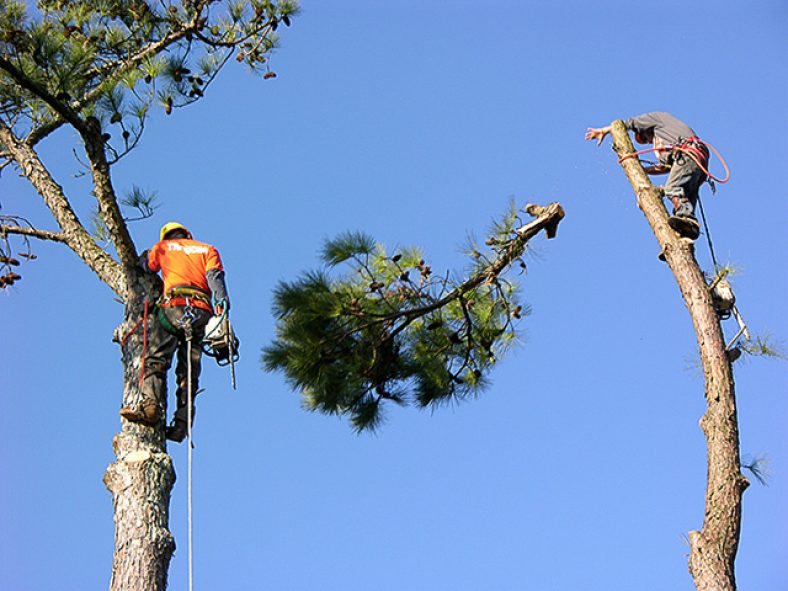The simple act of tree trimming does much more than one might think. It’s an essential task that leads to trees experiencing longer, healthier lives, which in turn affects the people, animals and other organisms around them. If the trees in an area are happy and healthy, then chances are everyone and everything else will also be happier and healthier. On the other “limb”, however, if those trees are miserable, sick or even dead then the local community around them will suffer, as well.
The easy (or not-so-easy, depending on how much the trimmer understands) task of tree trimming could help provide health and longevity in your community, which is why it’s important to understand the right and wrong ways to trim trees.
Safety First, No Matter What
Regardless of the right and wrong ways to trim a tree, what’s more important is the person’s safety. Even if they don’t know how to trim a tree, they at least know how to go about it in a safe way. Just remember, when you want to be safe, hang with your friends. Your friends in this situation are:
-
Goggles: Your eyes are the most important part of your body. I know they might look goofy, especially if you’re trying to make a fashion statement while trimming a tree branch, but slap some goggles on your face and get over yourself. Uninjured eye balls are way better than potentially missing out on picking up some ladies (or gentlemen) while trimming those trees.
-
Hard Hat: Again, you’re not making a fashion statement, so throw on a hard hat to protect your noggin.
-
Spotter: For those who don’t have enough experience or all the right safety equipment, but are still adamant about doing the job, have a friend spot your ladder or assist with rappelling up and down the tree.
-
Chainsaw Leggings: If you use a chainsaw, make sure you have some chainsaw leggings to protect your legs while you cut off branches. That’s way better than getting stitches.
Why to Cut
After your preparations to trim safely are complete, it’s important to understand why you’re even attempting to trim your trees. In case you’re unaware, there are many great benefits of doing so.
-
For the Tree: Obviously, the main reason to trim a tree is to improve its health and provide a longer lifespan for it.
-
For the Environment: A healthier tree ultimately leads to a healthier environment. A healthy tree will process more carbon dioxide and output oxygen providing cleaner air for its environment. Additionally, a healthier tree will be able to soak up more water in the case of a flood.
-
For the People: Healthier trees = cleaner air for people to breathe. It’s a simple cause and effect scenario. Not to mention, healthy trees provide a beautiful atmosphere for people to live in, which allows for greater peace of mind.
Okay, that explains why tree trimming is important, but it doesn’t cover why someone would need to cut a branch off of a tree in the first place.
-
Diseased/Damaged: A common reason to trim a tree is to lop off any dead branches the tree may be burdened with. If that’s the case, get those bad boys off there as soon as you can. They’re only inhibiting its growth.
-
Excessive Branches: Another common reason to trim a tree is clear out any excessive branches. Too many branches could encroach upon each others’ growth patterns and cause them to suffer. This lack of space could cause branches to rub against each other, resulting in bark erosion which leaves the tree’s health exposed to a greater chance of catching a disease.
-
Danger to Its Surroundings: The most common reason tree trimming occurs is due to the tree becoming a hazard to its surroundings, such as a limb overhanging a building or telephone line. When trimming to make an area safer, make sure to accommodate for intense weather (i.e. large gusts of wind!), which may cause the tree’s hazardous branches to reach even further and causing a branch to land on your home.
When to Cut
The best times to trim trees are in late fall or late winter because potential diseases won’t be active to infest a tree’s fresh wound in colder months. During the warmer months, however, a freshly trimmed tree allows for greater exposure to these potential diseases.
Where to Cut
Okay, now that you’re well prepared and know when and why you’re trimming your trees, now you can actually start to trim them…finally! When you make your first incision, be wary of where you’re cutting exactly. Don’t cut at the branches collar. That’s far too close to the tree’s body. If you look at the illustration below, you’ll be able to identify where the branch collar is. As you can see, the red dashed line is where you should cut; not parallel to the body of the tree, but slightly canted so it’s not exactly perpendicular to the branch.
Happy trimming!
Stewart Scott is a certified arborist and is the owner of Cevet, a tree trimming company in Columbia, Mo. Cevet has provided tree trimming and other tree care services to mid-Missouri for almost 20 years.

